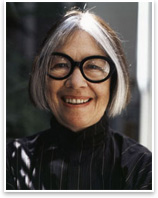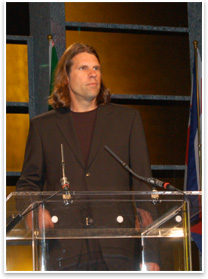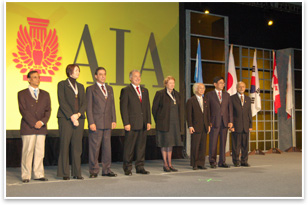|
The Power of Diversity: Focus on Emerging Voices
Summary: Thinking less about walls and more about relationships was the common thread for the May 2 AIA Convention theme session, said AIA President Marvin J. Malecha, FAIA.
 He began the session with the presentation of the 2009 AIA/ACSA Topaz Medallion to MIT School of Architecture and Planning Dean Adèle Naudé Santos, FAIA who spoke of the power of “changing the pragmatic into the poetic.” As only the second female to receive the Topaz Medallion, Santos reflected on the demographics of the profession over the course of 36 years since she herself graduated. Her generation was focused primarily on creating good architecture, she said, and was not particularly gender specific. If there were any watchwords of the day at Penn and U.C. San Diego, they were “damn the torpedoes” in their quest to understand the complexity of the profession, she remembered. He began the session with the presentation of the 2009 AIA/ACSA Topaz Medallion to MIT School of Architecture and Planning Dean Adèle Naudé Santos, FAIA who spoke of the power of “changing the pragmatic into the poetic.” As only the second female to receive the Topaz Medallion, Santos reflected on the demographics of the profession over the course of 36 years since she herself graduated. Her generation was focused primarily on creating good architecture, she said, and was not particularly gender specific. If there were any watchwords of the day at Penn and U.C. San Diego, they were “damn the torpedoes” in their quest to understand the complexity of the profession, she remembered.
The nature of the dialogue is changing, though, she said. People want role models. And, to some extent, they are getting them. For instance at MIT, which used to be a male bastion there has been a significant transformation, with the current enrollment being 53 percent women. There are still problems, she added, noting that gender equity still remains an issue. The problem is a general one, though, both internal and external to the profession. She called the women of her generation pioneers, “although I don’t like to think of myself that way,” she said. In a hopeful note Santos concluded that she looks forward to the many women of multi-ethnicity who will be so honored in the future as exemplars of architectural education.
A panel of visionaries
Saturday afternoon featured a dozen leading architects representing 10 cities, each showing a fast-paced slide show, speaking for four minutes apiece. The theme for the afternoon presentation was “Focus on Emerging Voices of Practice: Critical and New Opinions.”
Presenters, working with ideas and experimental forms and materials presented their work, built and unbuilt at every scale, the certain and uncertain, Malecha noted, as they each asked both why and why not. The diversity of ideas illustrated the richness of the profession, he said, pointing out that the panel was the perfect illustration that “there is no single way to see architecture.”
Sheila Kennedy, AIA, talked of her studies moving from 3D to 2D, and back again to gain a full understanding of her drawings. She focused on energy-efficient materials, including energy-harvesting textiles, she said, seeking a balance between industrial and craft.
Kulapat Yantrasast, Assoc. AIA, from Thailand began by equating food and architecture, seeking to achieve unity by diversity, and reflecting the complexity of the land to the form of the building.
Paul Lewis, AIA, spoke of interior engagement of occupants with engagement to “views beyond” and layered discontinuity and continuity.
Cameron Sinclair, Assoc. AIA, talked of his efforts—and those of many thousands of other architects—to bring relief and housing to the Gulf Coast after Hurricane Katrina. With funding in part from Oprah Winfrey, his efforts were able to bring safe, comfortable homes to people for less than $125 thousand. The result, he said, is that the effort allowed the many volunteers “to fall in love with being an architect again.”
Sebastian Schmaling, AIA, talked of the tactility and blending of color in his firm’s extensive use of models, from massing studies and explorations of tectonics to full-scale mock-ups for construction.
Philip Freelon, FAIA, displayed four of his firm’s museums and the sculptural qualities of his work emphasizing African American cultural influences, such as a Jacob’s ladder theme and an abstraction of the interlocking arms of Freedom Riders.
Jeanne Gang, FAIA, presented her Aqua Tower as well as other projects in Chicago and studies she has pursued in Germany and Brazil.
Tom Kundig, FAIA, spoke of the interaction in his office, 2009 Firm Award recipient Olson, Sundberg, Kundig, Allen. Residential projects are where the craft of architecture comes through most poignantly, he said, noting a trend he’s seeing where clients are moving toward smaller projects. For his firm’s work, the inside relates to the outside, and even though they are often working with harsh environmental conditions, they are always concerned with making homes. The same holds true for urban settings, he said.
Teddy Cruz imagined new concepts of ownership and sustainability in the context of cultural crisis. Selfishness runs counter to the need to increase density, but perhaps density is measured incorrectly. Instead of the number of people per acre, what if density were measured in the amount of socio-economic exchange within that acre? He put forward the idea of enhancing micro-economic value in development so that affordable housing supports neighborhood-scale socio-economic growth.
 Randy Brown, AIA, said the name of his home city, Omaha, means “go against the current,” which is what he is trying to do in recreating suburbia. His five points of light are: conservation, re-use, community, affordability, and diversity, he said, and explained how he became a developer to provide affordable suburban homes. “We have the power to make the change,” he said. Randy Brown, AIA, said the name of his home city, Omaha, means “go against the current,” which is what he is trying to do in recreating suburbia. His five points of light are: conservation, re-use, community, affordability, and diversity, he said, and explained how he became a developer to provide affordable suburban homes. “We have the power to make the change,” he said.
Nader Tehrani talked of working within limited budgets in Venezuela using basic materials—masonry and corrugated sheet—in creative ways. Taking on the means and methods of construction himself allowed him to compete in the construction industry, he said, while his experimentation with materials and construction methods allowed him to create a “stealth branding system.”
Lisa Iwamoto showed her firm’s origami-like structural and sheathing systems, which she initially modeled in paper to develop a more refined structural system, which translated well into wood and polyester to fulfill her clients’ programmatic needs.
To enjoy the full experience of the May 2 presentations, go online and view them for free for a limited time.
 Eight Presidential Medal recipients Eight Presidential Medal recipients
Honoring seven presidents of foreign national architectural associations and the president of the International Union of Architects, Malecha concluded the session by presenting Presidential Medals to, from left, Architects’ Regional Council of Asia Chairman Mubasshar Hussain; Australian Institute of Architects President Melinda Dodson, FRAIA; Colegio de Arquitectos de Costa Rica President Mario Álvarez Muñoz; Federacion de Colegios de Arquitectos de la Republica Mexicana President Lizandro de la Garza Villarreal, Intl. Assoc. AIA; International Union of Architects President Louise Cox, LFRAIA (Australia); Japan Institute of Architects President Yutaka Izue; Korean Institute of Registered Architects President Myung-soo Han; and Royal Architectural Institute of Canada Ranjit (Randy) K. Dhar, FRAIC, Hon. FAIA.
|



